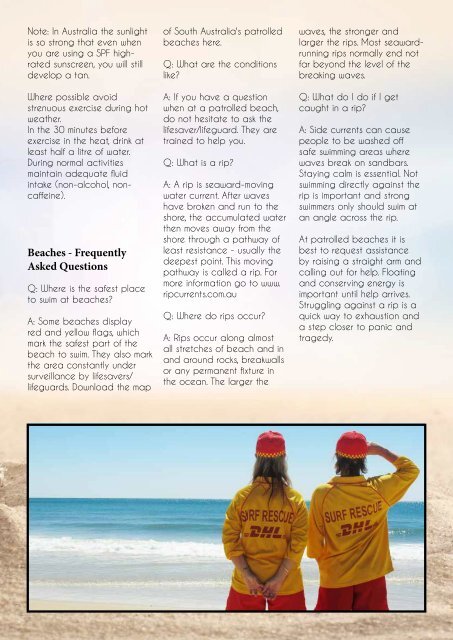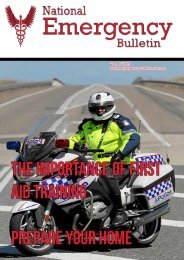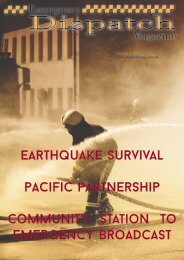National Emergency Magazine Vol. 4 2014
You also want an ePaper? Increase the reach of your titles
YUMPU automatically turns print PDFs into web optimized ePapers that Google loves.
Note: In Australia the sunlight<br />
is so strong that even when<br />
you are using a SPF highrated<br />
sunscreen, you will still<br />
develop a tan.<br />
Where possible avoid<br />
strenuous exercise during hot<br />
weather.<br />
In the 30 minutes before<br />
exercise in the heat, drink at<br />
least half a litre of water.<br />
During normal activities<br />
maintain adequate fluid<br />
intake (non-alcohol, noncaffeine).<br />
Beaches - Frequently<br />
Asked Questions<br />
Q: Where is the safest place<br />
to swim at beaches?<br />
A: Some beaches display<br />
red and yellow flags, which<br />
mark the safest part of the<br />
beach to swim. They also mark<br />
the area constantly under<br />
surveillance by lifesavers/<br />
lifeguards. Download the map<br />
of South Australia's patrolled<br />
beaches here.<br />
Q: What are the conditions<br />
like?<br />
A: If you have a question<br />
when at a patrolled beach,<br />
do not hesitate to ask the<br />
lifesaver/lifeguard. They are<br />
trained to help you.<br />
Q: What is a rip?<br />
A: A rip is seaward-moving<br />
water current. After waves<br />
have broken and run to the<br />
shore, the accumulated water<br />
then moves away from the<br />
shore through a pathway of<br />
least resistance - usually the<br />
deepest point. This moving<br />
pathway is called a rip. For<br />
more information go to www.<br />
ripcurrents.com.au<br />
Q: Where do rips occur?<br />
A: Rips occur along almost<br />
all stretches of beach and in<br />
and around rocks, breakwalls<br />
or any permanent fixture in<br />
the ocean. The larger the<br />
waves, the stronger and<br />
larger the rips. Most seawardrunning<br />
rips normally end not<br />
far beyond the level of the<br />
breaking waves.<br />
Q: What do I do if I get<br />
caught in a rip?<br />
A: Side currents can cause<br />
people to be washed off<br />
safe swimming areas where<br />
waves break on sandbars.<br />
Staying calm is essential. Not<br />
swimming directly against the<br />
rip is important and strong<br />
swimmers only should swim at<br />
an angle across the rip.<br />
At patrolled beaches it is<br />
best to request assistance<br />
by raising a straight arm and<br />
calling out for help. Floating<br />
and conserving energy is<br />
important until help arrives.<br />
Struggling against a rip is a<br />
quick way to exhaustion and<br />
a step closer to panic and<br />
tragedy.





